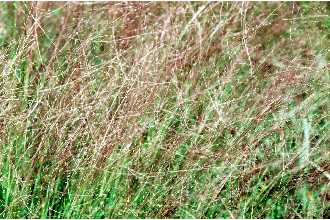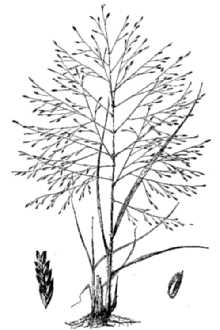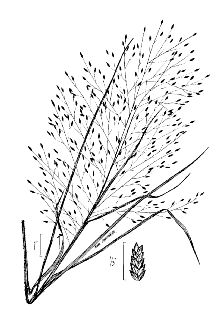Eragrostis spectabilis (Pursh) Steud. var. sparsihirsuta Farw.
Scientific Name: Eragrostis spectabilis (Pursh) Steud. var. sparsihirsuta Farw.

| General Information | |
|---|---|
| Usda Symbol | ERSPS5 |
| Group | Monocot |
| Life Cycle | Perennial |
| Growth Habits | Graminoid |
| Native Locations | ERSPS5 |
Plant Guide
Use a soil moisture meter to monitor the soil moisture where Eragrostis spectabilis (Pursh) Steud. var. sparsihirsuta Farw. is planted.
Fact Sheet
Alternate Names
petticoat-climber, tumble grass , Use soil moisture sensors to measure the soil moisture of Eragrostis spectabilis (Pursh) Steud. var. sparsihirsuta Farw..
Uses
Livestock readily graze purple lovegrass in the spring and early summer. On heavily grazed areas, deer dig up and eat the basal part of the stem during the winter.
Status
Please consult the PLANTS Web site and your State Department of Natural Resources for this plant’s current status, such as, state noxious status and wetland indicator values.
Description
Grass Family (Poaceae). Purple lovegrass is a native, warm-season, perennial bunch grass. The height is between 1 and 3 feet. The leaf blade is 8 to 18 inches long; densely hairy; stiffly ascending when young; tapers to fine point. The leaf sheath is longer than internodes; covered with long, gray hair. The ligule is hairy. The seedhead is open panicle 1 to 2 feet long and about as wide, bright purple until maturity; tuft of hair in axial of seed stalks, spikelets 6- to 12-flowered. Distribution: For current distribution, please consult the Plant Profile page for this species on the PLANTS Web site.
Management
This grass adds variety to livestock diet but is seldom abundant enough to be a key management species. It makes maximum production when no more than 50 percent of current year's growth by weight is grazed off. A summer grazing deferment of at least 90 days improves plant vigor. This grass increases under controlled annual burning.
Establishment
Growth starts in the early spring and continues into the fall. Purple lovegrass grows in colonies. It never makes up a large percentage of plant composition. The seedheads are weak, break off easily, and tumble in the wind. Some plants produce short, slender rhizomes. It is primarily adapted to medium- and coarse-textured soils. Cultivars, Improved and Selected Materials (and area of origin) Please contact your local NRCS Field Office.
Plant Traits
Growth Requirements
| Temperature, Minimum (°F) | -43 |
|---|---|
| Adapted to Coarse Textured Soils | Yes |
| Adapted to Fine Textured Soils | No |
| Adapted to Medium Textured Soils | Yes |
| Anaerobic Tolerance | None |
| CaCO3 Tolerance | Low |
| Cold Stratification Required | No |
| Drought Tolerance | High |
| Fertility Requirement | Low |
| Fire Tolerance | None |
| Frost Free Days, Minimum | 100 |
| Hedge Tolerance | None |
| Moisture Use | Low |
| pH, Maximum | 7.5 |
| pH, Minimum | 4.0 |
| Planting Density per Acre, Maxim | 43560 |
| Planting Density per Acre, Minim | 10912 |
| Precipitation, Maximum | 60 |
| Precipitation, Minimum | 10 |
| Root Depth, Minimum (inches) | 4 |
| Salinity Tolerance | None |
| Shade Tolerance | Intolerant |
Morphology/Physiology
| After Harvest Regrowth Rate | Slow |
|---|---|
| Toxicity | None |
| Resprout Ability | No |
| Shape and Orientation | Erect |
| Active Growth Period | Spring |
| Bloat | None |
| Coppice Potential | No |
| Fall Conspicuous | No |
| Fire Resistant | No |
| Flower Color | Green |
| Flower Conspicuous | No |
| Foliage Color | Green |
| Foliage Porosity Summer | Porous |
| Foliage Porosity Winter | Porous |
| Fruit/Seed Color | Yellow |
| Nitrogen Fixation | None |
| Low Growing Grass | No |
| Lifespan | Moderate |
| Leaf Retention | No |
| Known Allelopath | No |
| Height, Mature (feet) | 0.9 |
| Growth Rate | Moderate |
| Growth Form | Rhizomatous |
| Fruit/Seed Conspicuous | Yes |
| Foliage Texture | Fine |
Reproduction
| Vegetative Spread Rate | Moderate |
|---|---|
| Small Grain | No |
| Seedling Vigor | High |
| Seed Spread Rate | Slow |
| Fruit/Seed Period End | Fall |
| Seed per Pound | 1059100 |
| Propagated by Tubers | No |
| Propagated by Sprigs | No |
| Propagated by Sod | No |
| Propagated by Seed | Yes |
| Propagated by Corm | No |
| Propagated by Container | No |
| Propagated by Bulb | No |
| Propagated by Bare Root | No |
| Fruit/Seed Persistence | No |
| Fruit/Seed Period Begin | Summer |
| Fruit/Seed Abundance | High |
| Commercial Availability | Contracting Only |
| Bloom Period | Spring |
| Propagated by Cuttings | No |
Suitability/Use
| Veneer Product | No |
|---|---|
| Pulpwood Product | No |
| Post Product | No |
| Palatable Human | No |
| Palatable Graze Animal | Medium |
| Palatable Browse Animal | Medium |
| Nursery Stock Product | No |
| Naval Store Product | No |
| Lumber Product | No |
| Fodder Product | No |
| Christmas Tree Product | No |
| Berry/Nut/Seed Product | No |



